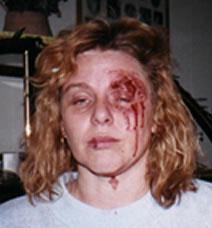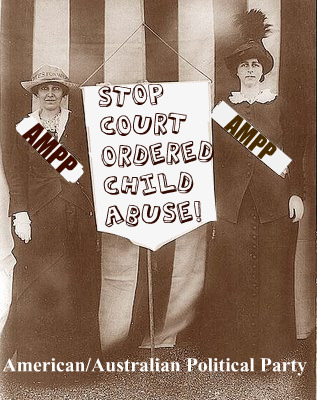Americans For Prosperity and Kansas Judges-Claudine Dombrowski
July 31, 2010---Happy Anniversary you sick shit—I have not forgotten you---I Have not gone away ---I will NOT SHUT UP and YOU are not forgotten--
Ten Years ago--July 31, 2000, Judge Richard D. Anderson Shawnee County Court, of Topeka Kansas Made a 'deal' with prior Judge James P Buchele - to "Take the child away from mother-give her to her known rapist and drug/alcohol wife beating father—DADDY HAL RICHARDSON So he could become Chief Judge" --he did- and he did.
Judge Richard D. Anderson Shawnee County Court
Shawnee County District Court-- Topeka, Kansas, 200 SE 7th Street 66603 Div 2 - Hon. Richard D. Anderson (785) 233-8200 Ext. 4350
Order without motion from either party WITHOUT Hearing on his OWN—I REPEAT on his own
Took my daughter and gave her to a KNOWN AND convicted Batterer and drug abuser AND CHILD RAPIST
CRIMINAL Halleck George RICHARDSON II, TOPEKA KANSAS MINUTE MAN SOLOR FILM TOPEKA KANSAS
NOTE TO THE MEDIA: Trag·e·dy (trj-d) n. pl. trag·e·dies - 1. A drama or literary work in which the main character is brought to ruin or suffers extreme sorrow, especially as a consequence of a tragic flaw, moral weakness, or inability to cope with unfavorable circumstances...
THESE CASES ARE NOT "TRAGEDIES". THEY ARE
OUTRAGES:
Bad laws, bad decisions, bad judges, bad experts, bad ethics, bad ideas, and other things that are BAD FOR CHILDREN
KANSAS
CLAUDINE DOMBROWSKI CASE, Shawnee County, Kansas. Claudine lost custody of her baby daughter Rikki to Hal Richardson, the man who did this, thanks to Judge James P. Buchele, who refused to permit adequate testimony at trial, shortening it to benefit his docket, and also ordered Claudine to move back to Topeka to live near Richardson, for the sake of their "co-parenting." WHAT?! Richardson is a man with multiple criminal convictions for violent behavior (Battery, Attempted Battery, Battery of a Law Enforcement Officer, Obstruction of Legal Process, Possession of Marijuana and violation of Open Container law), a man who has beaten and raped Claudine multiple times before and after her divorce from him, a man who has threatened to kill her and her child.
Worse, Judge Buchele also ordered Claudine not to call the police any more without the permission of her case manager. When Judge James Buchele retired, Judge Richard D. Anderson affirmed Buchele's previous orders, including the illegal prohibition on Claudine's being able to call the police.
But don't blame the judges alone. Stupidity rarely works its evil in a vaccuum. A truly egregious outrage requires that could-be good men do nothing. Guardian ad litem Scott McKenzie deserves a substantial portion of the credit for this travesty. I ask, how in hell can this happen in the United States of America? For more information, also see http://www.kansas.net/~freepress/7-12-01-8.html
RICHARD ANDERSON---- Topeka Kansas Courts Have Continued Abuse Of Manhattan Woman
By Jon A. Brake
Manhattan Free Press
MANHATTAN, KS - To some this could be considered beautiful. Solid mahogany is beautiful when given a high finish and it does have a high finish. It is about four to four and a half feet long, a foot and a half high; with shinny brass handles at the foot and head. A child's coffin, in this home has been turned into a coffee table.

To Claudine Dombrowski it is not beautiful, that is her daughter, six-year-old Rikki on the couch behind the threatening coffee table. If a coffin coffee table is not enough, a hunting rifle hangs on the wall above the couch.
Claudine, a Manhattan resident, was divorced from Hal Richardson in Shawnee County District Count in 1997. She had been a repeat victim of Domestic Violence and a repeat victim of the State Court System.
What does the Court System think of the coffin coffee table? In a letter to Shawnee County District Court Division Two Judge Richard D. Anderson, Harry Moore, with the Court Services stated: "When I was at the house, I did not recognize anything which in my experience resembled a child's coffin. After looking at the picture and speaking with Mr. Richardson, I have come to find out that it is indeed a coffin and that it was an antique which he purchased in Mexico several years ago and uses as a coffee or end table of sorts."
What about the rifle? Mr. Moore said, "There is also a secured hunting weapon hanging on Mr. Richardson's wall. The thing which is striking about this specific issue is that it contains a remarkable leap of logic. For instance, I am the owner of a 7.9 mm Mauser rifle which was the standard issue firearm for the German soldier in World War II. This weapon was procured by my father who served in Europe during the war. This weapon also hangs on the wall in my rec room. Does my ownership and display of this firearm lead one to the conclusion that I am a Nazi?"
The question Mr. Moore failed to answer is: "Is it a leap of logic for an abused woman to see the child's coffin and the rifle as more than furniture? Is there a message to the mother? The Shawnee District Court has missed many messages when it comes to the violence in this case.
When reading Court documents it is clear that attorneys have intentionally muddied the waters. It was a nasty divorce, those things happen. Eight or more attorneys, three different Judges and several Court Service workers have filed motion after motion. In the end a Judge wants to compel a dysfunctional family to be normal. It can't be done.
Halleck (Hal) Richardson and Claudine Dombrowske lived together for several months before they were married on November 22, 1995. Divorce papers were filed four month later. By this time records show Hal Richardson had abused Claudine and he had Domestic Battery and Criminal Damage to property convictions.
Hal had seven other convictions before 1995. The convictions were for Battery, Attempted Battery, Battery of a Law Enforcement Officer, Obstruction of Legal Process, Possession of Marijuana and an Open Container conviction.
Most of the Probation Conditions were never followed up on by court officials. After the Domestic Battery conviction, Hal was ordered to attend an "Alternatives to Battering Program" put on by the Battered Women Task Force in Topeka. A few of the comments made on Hal's report were: "Client rude and disrespectful to female co-facilitator as evidenced by his combative stance, his repeated interruptions, his sexist language and his refusal to accept any responsibility."
Another report stated: "Client very disruptive during group, this was evidenced by the fact that he interrupted the facilitator repeatedly by making rude comments, laughing and telling inappropriate sexist jokes."
And finally: "Called PO (probation officer) and client to tell them that he had graduated as far as I was concerned. He only has 17 sessions, but is causing too much trouble with his mouth. Terminated, with cause. Will not be accepted back."
The divorce proceedings were extended for eighteen months. Throughout the proceedings Claudine's attorneys filed numerous reports claiming violations of the restraining order and requesting an order to sever contact between Hal, Claudine and daughter Rikki.
The first involved an incident that both parties agreed in court happened, they just could not agree what happened. Claudine said she was hit in the head with a crow bar and Hal said it was a piece of wood. What ever he hit her with it took 24 stitches to close the head wounds.
At a hearing on June 17, 1996 Shawnee County District Court Judge Jan W. Leuenberger signed order giving custody of Rikki to Claudine and authorizing her to move to the Great Bend area so that "Ms. Dombrowski could avoid the history of physical and verbal abuse she had suffered from Mr. Richardson."
Hal was given supervised visitation.
As in many divorce cases the Judge on November 5, 1996 appointed Mr. Scott McKenzie, Attorney at Law, to serve as Guardian ad Litem to appear on behalf of Rikki. Mr. McKenzie was very experienced in juvenile court proceedings with more than 1,000 cases but this was only his sixth Guardian ad Litem. Under Mr. McKenzie direction visitation terms were worked out to where Claudine would keep Rikki for three weeks and then Hal would have her for a week.
Before the Divorce Trial started a new Judge took over. Judge James P. Buchele replaced Judge Leuenberger.
It is about this time the Court and Court appointed case workers attitued changed. Judge Buchele saw that fifty people were being called as witnesses for the trial. He placed a limit of five for each side. This can be done but it can cause problems. Court documents state: "These limits made it difficult or impossible for Ms. Dombrowski to bring in all of the witnesses to corroborate here clams." During the trial the Judge would not allow hearsay evidence but the proper witness was not there to testify.
At trial Mr. McKenzie indicated, "after reading the police reports of the violence, and the doctor's reports, he was not able to validate any of the truth of any of the accusations of violence made by Ms. Dombrowski."
When asked about Mr. Richardson's criminal history Mr. McKenzie recalled only a single offense for driving under the influence of alcohol, and was unaware of the misdemeanor convictions including the domestic violence battery against Claudine. He was unaware of a misdemeanor battery for a bar fight and the battery of a law enforcement officer.
Records of the Battered Women's Task Force had never been reviewed by Mr. McKenzie. Even thou Claudine had received support from the facility. In a report to the court Mr. McKenzie had recommended anger management therapy for Claudine but not for Hal.
In Judge Buchele's Orders after the trial he made it clear that he wanted more from this couple than what was possible. Here is what he wrote: "Mutual parental involvement with this child has been made worse by Ms. Dombrowski's unilateral decision to move to Larned, Kansas in May of 1996. The distance between Topeka and Larned makes it virtually impossible for an individual treater to work with the family; for Mr. Richardson to have regular and frequent contact with this child; to establish any reasonable dialogue between the parents toward resolving their conflicts. The move from Topeka to Larned, due to the proximity of the parties, has lessened the physical violence. It has, however, done violence to the relationship of Rikki and her father. If long distance visitation is continued, in the Court's view, will take its toll not only on Rikki but each of the parties. The Court specifically finds that separation of the child from either parent for long periods of time is harmful for a child of about three years of age."
He then went on to require Claudine to move back to the Topeka area.
And then Judge Buchele made a judgment that some Manhattan attorneys say is not legal. Judge Buchele ordered: "Further, respondent (Claudine) is directed to not call law enforcement authorities to investigate the petitioner (Hal) without first consulting with the case manager."
On December 14, 2000 after returning her daughter to her fathers home Claudine alleges that she was battered and raped by Hal. Under order not to call law enforcement authorities and with bleeding that would not stop, she drove to St. Marys, Kansas to get treatment. Claudine knew that if she had gone to a Topeka Hospital they would have called the police.
In St. Marys hospital officials did contact the Pottawatomie Sheriff and a report was made. She was advised that because the alleged event occurred in Shawnee County she would have to file there. Claudine said that because of the battery and rape she picked up Rikki the next day and did not return her. The Shawnee County Sheriff's Department was called and took Rikki back to Topeka. The court gave Hal custody and orders for her to attend Topeka schools.
As it stands now, Rikki is with her father in Topeka. Claudine gets two one-hour visits per week. The child will go to school in Topeka unless a new motion, which will be filed this week, is granted. The motion will request that Claudine be given custody and Rikki be allowed to attend school in Manhattan.
This case has received national attention by the National Organization for Women; the Judicial Initiative Commission Hearing by the Citizens for Good Judges and it was told to the Kansas Justice Commission in 1997.
A new Judge will be hearing the motion. Judge Richard D. Anderson took over the case on the retirement of Judge Buchele. But, unless Claudine receiveds help from Kansas citizens, the abuse will continue. In July of 2000 Judge Anderson reaffirmed all of Judge Buchele's previous orders. Evan the order to not call law enforcement authorities
Webmaster Note: You can contact Judge Richard D. Anderson at (785) 233-8200 ext. 4350
OUT RAGES
Claudine Dombrowski Photos of Abuse
As you view these photos keep in mind that the court awarded FULL CUSTODY of their daughter to the "man" who did this to Claudine.
To read Claudine's history that was submitted to the IACHR, click here
If you want to know some of the many reasons women stay in abusive relationships, click here
AFTER THE BIRTH OF HER DAUGHTER, 1994
AFTER EX-HUSBAND BEAT HER WITH A CROW BAR, 1996
AFTER EX-HUSBAND RAPED AND BATTERED HER, 2000

AFTER EX-HUSBAND HIRED SOMEONE TO ASSAULT HER, 2003
THE "COFFEE TABLE" IN THE FATHER'S HOME IS A CHILD'S COFFIN. MOUNTED ON THE WALL ABOVE THE SOFA IS A GUN.
What Litigation Abuse Looks Like! It Boggles The Mind That Each Line Represents a Trip to Court. This is a KANSAS CASE! The Claudine Dombrowski Case.
Claudine Dombrowski Photos of Abuse | Stop Family Violence There is a crisis in our nation’s family courts. Judges are awarding child custody to abusers and pedophiles and punishing the safe parent who tries to … As you view these photos keep in mind that the court awarded FULL CUSTODY of their daughter to the[more...]
-
CONFIRMED: PROTECTIVE MOTHERS WERE RIGHT
-
A special Mothers Day Article
By Barry GoldsteinFor many years, protective mothers have complained about a broken custody court system giving custody to abusive fathers. The courts dismissed the complaints by saying they came from disgruntled litigants. Now, a new book based on multi-disciplinary research has confirmed that common mistakes in the custody[more...]









